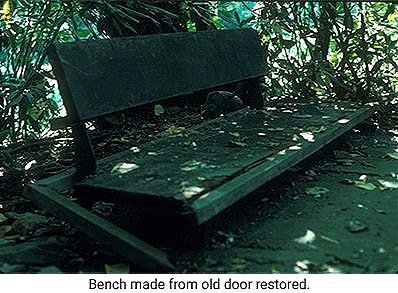Ridgewood Rehab
By 1991, Rose’s Ridgewood home had decayed considerably. Upon his death in the late summer of that year, a few of his friends began the work of converting his Ridgewood property into a landscape research and study center, something he had been looking into doing himself for some time. During the winter and spring of 1992, the home remained unoccupied and in disrepair while an educational foundation was established and a plan was developed.
It seemed like almost everything at Ridgewood was broken or in decay in 1991. Among the first things rebuilt was a low, elegant metal-and-wood bench visible from the main interior gathering space across the largest pool. True to form for Rose, during its reconstruction it was discovered that this refined bench was actually made from an old door. All the leaking pools were rebuilt, with the old hose nozzles again making fountains when reattached to new submersible pumps. Volunteers rebuilt and replanted the garden, reestablishing privacy on the eastern side of the property by adding more native rhododendrons, hemlocks, and Japanese black pines to the surviving ones.
On the western side, adjacent to Southern Parkway, the woven cedar fence had rotted and collapsed; it was rebuilt using as much of the original wood as could be salvaged, along with new cedar planks and posts, and eventually all of the perimeter fences were reconstructed. Rose’s River of Hospitality mural, covering a portion of an outside wall and continuing through a door onto an inside wall, was also restored.
In 1998–1999, following passage of the New Jersey Rehabilitation Subcode, the Center initiated major repairs to the Ridgewood property, including a new roof and the rebuilding of the roof garden. Today the home and garden is in need of more major repairs.




